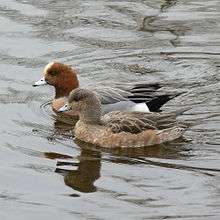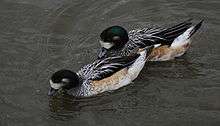Wigeon
| Wigeons | |
|---|---|
 | |
| Male (rear) and female (front) Eurasian wigeons.
Recorded Dorset, England | |
| Scientific classification | |
| Kingdom: | Animalia |
| Phylum: | Chordata |
| Class: | Aves |
| Order: | Anseriformes |
| Family: | Anatidae |
| Genus: | Anas |
| Subgenus: | Mareca |
| Species | |
The wigeons or widgeons are dabbling ducks in the genus Anas.
Biology

There are three extant species: the Eurasian wigeon (Anas penelope), the American wigeon (A. americana) and the Chiloé wigeon (A. sibilatrix). A fourth species, the Amsterdam wigeon (Anas marecula), became extinct in the 19th century. The wigeons are closely related to the gadwall and the falcated duck.[1][2]
All three wigeons are similarly shaped, with a steep forehead and bulbous rear to the head. Males have a distinctive breeding plumage, in their eclipse plumage they resemble females, which are similar in appearance year-round. The three species' closest relatives within the genus Anas are the gadwall and the falcated duck.[1] All three wigeon species hybridise in captivity[3] while American and Eurasian wigeons hybridise in the wild.[4] An American wigeon × mallard hybrid has also been recorded.[5]
The American wigeon was formerly called the baldpate by ornithologists, and some people still use that name, especially hunters.
The diet of the wigeon consists mainly of grass leaves (~80%), other food types eaten are seeds (~10%) and roots and stems (~5%).[6]
References
- 1 2 Johnson, KP; Sorenson, MD (1999). "Phylogeny and biogeography of dabbling ducks (genus: Anas): A comparison of molecular and morphological evidence" (PDF). The Auk. 116 (3): 792–805. doi:10.2307/4089339.
- ↑ Gonzalez, J.; Düttmann, H.; Wink, M. (2009). "Phylogenetic relationships based on two mitochondrial genes and hybridization patterns in Anatidae". Journal of Zoology. 279: 310–318. doi:10.1111/j.1469-7998.2009.00622.x.
- ↑ Jiguet, Frédéric (1999). "Photo-forum: hybrid American Wigeons". Birding World. 12 (6): 247–52.
- ↑ Carey, Geoff J. (1993). Hybrid male wigeon in East Asia Hong Kong Bird Report 1992 160-6
- ↑ Fedynich, Alan M. & Rhodes, Olin E., Jr. (1993). "Mallard × American Wigeon Hybrid on the Southern High Plains of Texas". The Southwestern Naturalist. 38: 179. doi:10.2307/3672079.
- ↑ Owen, Myrfyn; Thomas, G. J. (1979-01-01). "The Feeding Ecology and Conservation of Wigeon Wintering at the Ouse Washes, England". Journal of Applied Ecology. 16 (3): 795–809. doi:10.2307/2402854. JSTOR 2402854.
Further reading
- Bailey HH (1919). "An interesting hybrid of Mareca penelope (Widgon) and Mareca americana (Baldpate)". Wilson Bulletin. 31: 25.
- Cox C, Jessie B. "Aging of American and Eurasian Wigeons in female-type plumages" (PDF). Birding. 37 (2): 156–164.
- Harrison JM, Harrison JG (1968). "Wigeon × Chiloé Wigeon hybrid resembling American Wigeon". British Birds. 61: 169–171.
- Harrop A (1994). "Photo-forum: a presumed hybrid American Wigeon in Grampian". Birding World. 7: 116–7.
- Harrop A (1994). "Field identification of American Wigeon". Birding World. 7: 50–56.
- Jiquet F (1999). "Photo forum: Hybrid American Wigeons". Birding World. 12: 247–252.
- Larkin P (2000). "Eyelid colour of American Wigeon". British Birds. 93: 39–40.
- MacKay A (1996). "Hybrid wigeon resembling American Wigeon in Leicestershire". Birding World. 9: 146–7.
- Shiota T (1987). "A challenge in the identification of hybrid American and Eurasian Wigeon". Yacho. 496: 6, 18–19.
- Votier SC, Harrop AH, Denny M (2003). "A review of status and identification of American Wigeon in Britain and Ireland". British Birds. 96: 2–22.
- Watson GE (1970). "A presumed wild hybrid Baldpate × Eurasian Wigeon". The Auk. 87 (2): 353–7. doi:10.2307/4083926.
External links
Photographs of hybrid wigeons can be seen here and here.